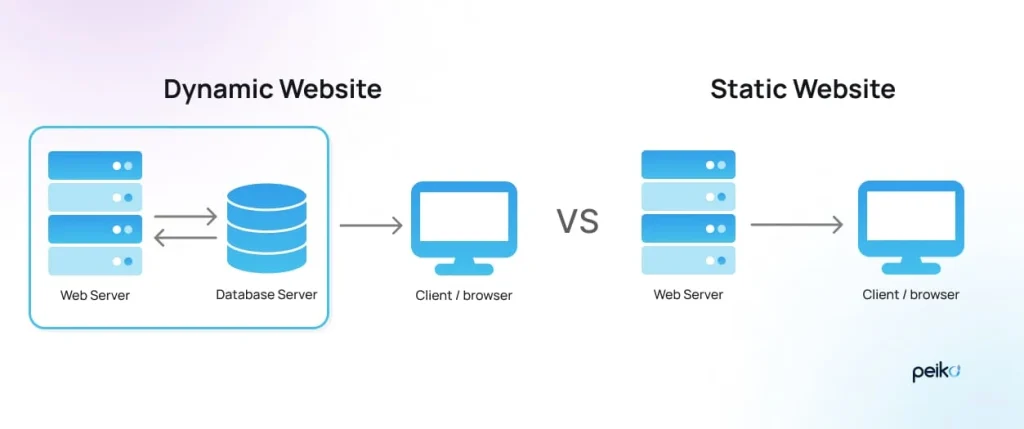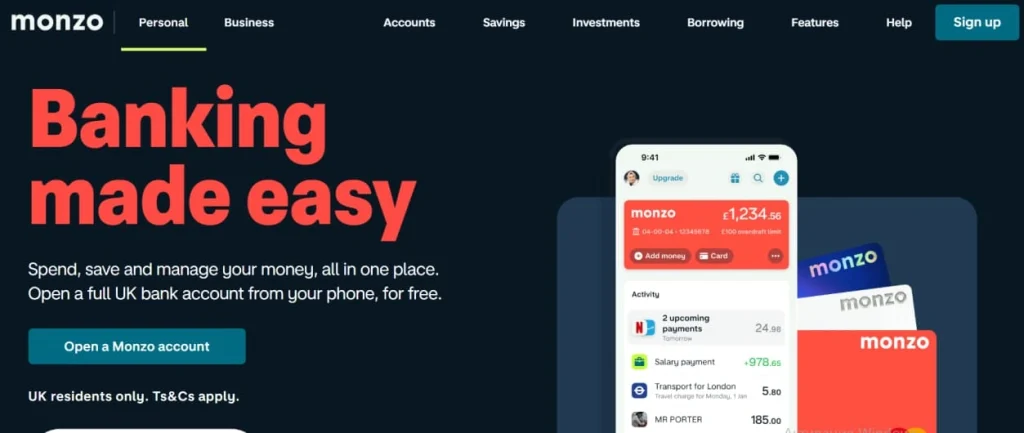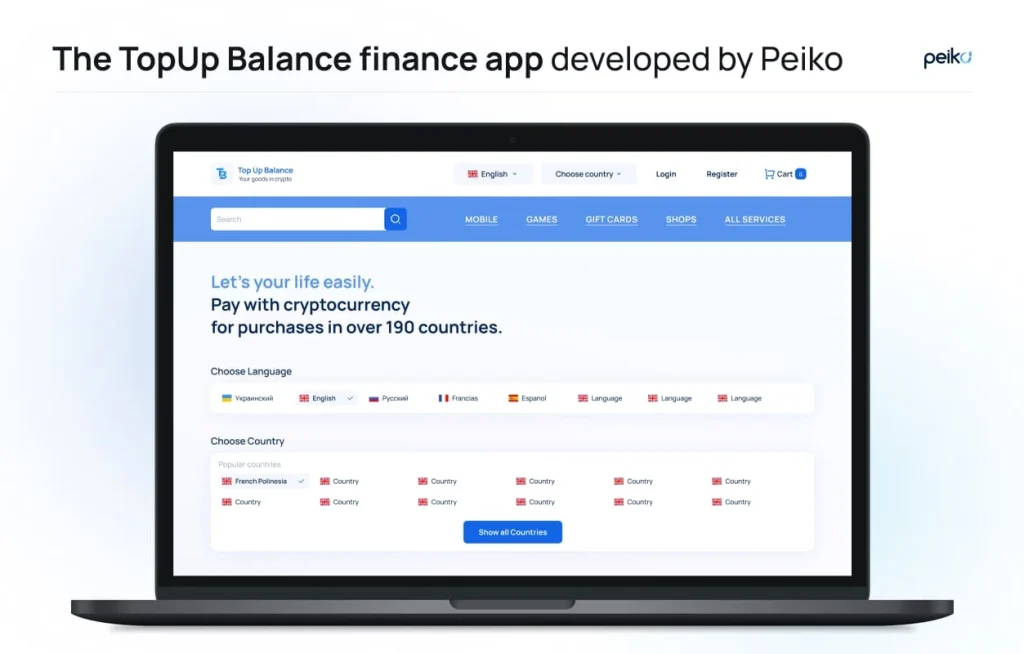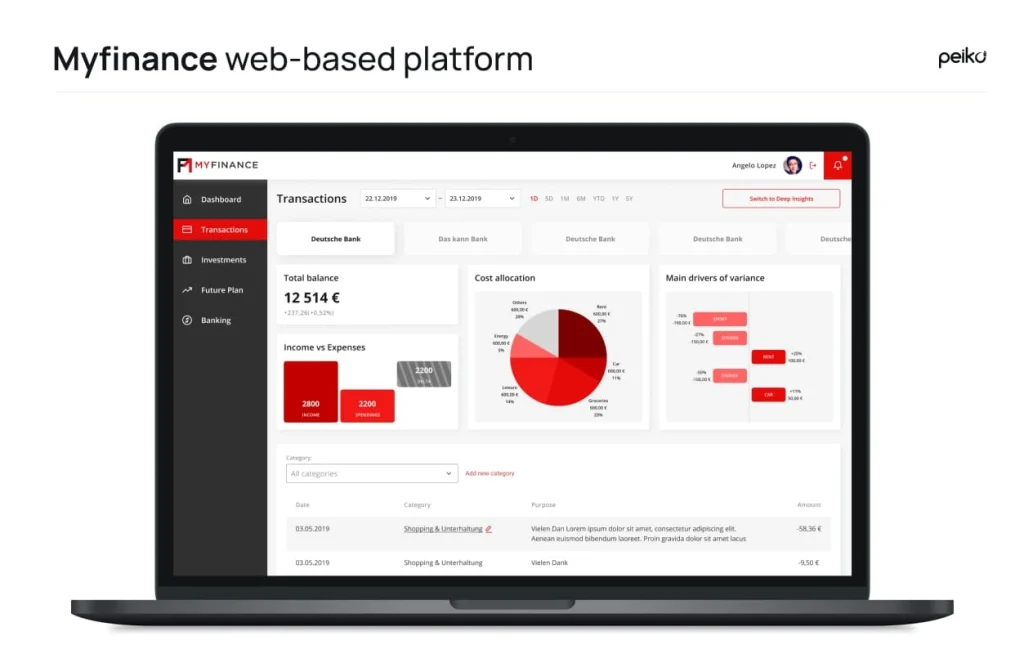Having a website is a must-have for the brand’s online presence. With its help, you will quickly let users know who you are, why you are unique, and what exclusive offers you have for them.
But what if you need more than just informing your audience about your services? For example, you may want users to ultimately take a specific action, such as a purchase, order, or transaction directly with you. For this purpose, be ready to go to the next level – web applications. Here, you no longer inform users but provide the necessary functions for their actions.
In general, web applications focus on providing interactive software solutions through the browser, requiring authentication and employing server-side and client-side scripts. On the other hand, websites primarily offer visual and textual content for users to access through a web browser, encompassing various types and purposes.
In this article, we will consider the difference between website and web application, discover their applications, and web app vs website examples. You will also understand which tool is best for increasing your brand awareness.
So, let’s begin our research!
Exploring the distinction: web applications vs websites
Let’s delve into a comparison between a web application vs website, uncovering the unique characteristics of each.
A web application is essentially a software program accessible through a web browser. It typically requires user authentication to access its functionalities. Combining server-side scripts with client-side scripts, a web application presents dynamic information to users. It relies on a server to handle user requests and manage data transactions. Some notable web app vs website examples include Google Docs, Pinterest, and Uber.
On the other hand, a website is a compilation of interconnected web pages comprising various multimedia elements such as images, text, audio, and video. It can range from a single page to multiple pages, catering to diverse content needs. Websites primarily offer visual and textual content for users to browse and consume.
For instance, a restaurant’s website may showcase its menu and operating hours, and a forum or blog serves as a platform for discussions and sharing information. Accessing a website simply requires a web browser such as Chrome or Firefox.
Below, we prepared a comparison table that will help you better understand the main differences between a web application vs website.
| Feature | Web app | Website |
|---|---|---|
| Interactivity | High, often includes complex features | Limited, primarily informational |
| Functionality | Dynamic, interactive tasks | Static, provides information |
| User interaction | User input is integral for functioning | User interaction is limited |
| Data storage | Stores user-specific data | Usually does not store user data |
| Access | Often requires login and authentication | Open access, no authentication required |
| Updates | Frequent updates and real-time data | Periodic updates for content changes |
| Purpose | Task-oriented and goal-driven | Information dissemination |
| Examples | Gmail, Trello, Google Maps, Wikipedia | Blogs, news websites |
Later in the article, we will take a closer look at each of these two types of software solutions.
Delving deeper into websites
In this section, our experts will explore websites in more detail and uncover their various aspects and functionalities.
A website is a collection of web pages collected under a unique domain name. They are publicly available, united by a coherent structure, and linked together to provide better navigation for both users and search engines. Although each site may have different intended uses, they generally share a common feature of focusing on information. The easier it is to convey it to the target audience, the more likely it is that users will not leave the site after a few seconds but, on the contrary, will stay on your site for a long time.
However, the visual side of the issue is just as important. A poor design can greatly affect the user bounce rate. Another factor to consider is your site’s cross-device responsiveness – it should work equally well on desktops, laptops, tablets, and phones. In the fourth quarter of 2023, mobile devices (excluding tablets) generated 58.67% of global website traffic.
Thus, by making your website mobile-friendly, you give users the ability to navigate on the go and increase the chances of them staying with you for as long as possible.

Reasons to create a website
A significant majority, around 73%, of small enterprises recognize the value of having a website as it serves as their online representation, fostering customer trust and leaving a lasting initial impression. This understanding is precisely why they have invested in establishing a website.

Also, below, you can check out the top arguments to get inspired and develop your website.
1. Tell others about your services
A website is ideal for hosting and updating your visual and textual content. The latter helps users learn about your value proposition in the market. To make it modern, you can also add some interactive elements to your site, such as a contact form, online chat support, quizzes, subscriptions, special offers for sharing personal information, and others. Don’t miss the chance to be memorable, but remember to be clear first.
2. Run a company blog
One of the best ways to drive more organic traffic to your website is blogging. Once users come to your online business space, you need to engage them to prove that you are worth their attention. Although it all depends on the specifics of your business, the most common tactic involves providing helpful information. You can demonstrate your expertise by giving examples from real life and sharing your experience in solving their problems. After all, a professional blog convinces your readers that you are worth trusting.
3. Increase sales
Do not forget about relevant CTAs (call-to-actions) when filling the site with content. These messages should be clearly visible to guide your target group to the desired actions – conversions. Usually, CTAs are applied to sell a product or service. They can also be used for new registrations, subscriptions, clicks to try for free, and more. Try not to sound intrusive with call-to-actions, but clearly show the expected scenario of your client’s actions.
4. Maintain a regular online presence
In order for new customers to learn about your company, you must not only create a website but also regularly update it with new and valuable information. Updates should be a friendly reminder to those who know of your existence and are interested in the new offer. Double your chances of targeting your intended audience with different types of content, attractive offers, responsive widgets, or other special offers.
Summarizing the above information, we would like to emphasize once again that blogging, having a regular presence on the Internet, and talking about your services are important factors in creating your website.
Pros and cons of websites
Having your own website has certain advantages and drawbacks. Let’s take a look at them.
Pros of a website
- Credibility boost: The mere existence of a company website increases your credibility, not to mention the opportunity to get more customers with real customer reviews, an intuitive user interface, and a responsive UX (user experience) design.
- Audience segmentation: Using the website, you can segment your audience by geolocation, age, gender, and other defining factors and tweak your messaging for stronger connections – the essence of online business promotion.
- Information sharing: With a website, you can easily share information that can make your customers’ lives easier, provide educational value, or educate users in your area of expertise.
- 24/7 accessibility: A website enables users to have unlimited access to your site’s information 24/7.
- Cost-effective and quick exposure: It is a relatively cheap and quick way to introduce your service, product, or brand to a wider audience – expanding your reach is literally at your fingertips.
Cons of a website
- Limited interaction elements: It may contain some interaction elements, but its list is quite limited, making a sharp difference between a website and a web application.
- Challenges with content display management: It gives a limited opportunity to manage the display of content depending on audience segmentation, and this is only if it supports seamless integration with CRM (customer relationship management).
- Data security concerns: Your data can be stolen or misused by other parties, which often forces you to file complaints and rewrite content to maintain the site’s uniqueness and ranking.
- Tech issues with high load: If your audience is large, sometimes your site may experience technical problems and not work until the error is fixed.
- Narrow functionality choices: As a rule, a website has a narrow choice of functionality, especially if it is made using a ready-made template.
You should consider all the pros and cons of developing a website to craft a digital strategy that aligns seamlessly with your business goals, ensuring a meaningful and impactful online presence.
Types of websites
When creating a new website, you have to define a purpose. You have two ways of achieving it – through static or dynamic content organization.

Static websites
If your business is small and you can write your home page, about page, and description of your services once and forget about it for a while, static websites are the best choice.
Creating a website with static content and disposable HTML and CSS requires less technical knowledge. WordPress is a good solution for small 3-5 page sites that will load quickly and host at a low cost. Resume builders, portfolio sites, landing pages, blogs, and read-only informational brochures all follow this path.
Below is a great example of a static website. It is Nathaniel Koloc’s personal blog.

Dynamic websites
This type gives you more functional flexibility, allowing you to engage with users on a deeper level and customize content based on location, local time, and language preferences. This is where data management becomes more professional, and you can even turn your websites into a community that offers memberships, newsletters, online offices, and other perks for loyal customers.
In this case, you will make your content more restricted and secure. However, this requires knowledge of programming languages (JavaScript, PHP) and download time.
Now, we will give one website vs web application example that many of you know. Netflix is a famous dynamic entertainment platform that showcases personalized TV and movie suggestions tailored to users’ preferences and profile settings. The interactive nature of Netflix’s interface has played a key role in shaping the streaming giant that it is today.

Delving deeper into the web application
Web-based apps are software that do not need to be downloaded from the store or installed on your device. Like a website, it can be opened using a browser if you have an Internet connection. The main distinguishing feature of web application sites is their focus on functionality. Here, information and educational content recede into the background, but the main thing is to serve the consumer by solving a specific problem.
Reasons for creating a web application
These four arguments will not leave you indifferent if you are considering a web application for your business, so check them out.
1. Add the necessary functionality
Unlike a website, a web application allows users to read content and manipulate data based on their input. A clear example is Wikipedia, where registered users can participate in creating, editing, or expanding an article.
2. Process automation
With web applications, you can give users the ability to search your product catalog and make online purchases with just a few clicks. E-commerce will greatly benefit from developing e-business solutions that are compatible with CRM systems such as eBay, Amazon, and AliExpress.
3. Protection of confidential user data
Although authentication is rarely a requirement for website use, it appears to be part of the registration process for web applications. Creating an account with a strong password and unique access data prevents your data from being hacked and used by attackers. In the sphere of banking, this is already a must-have.
4. Provide more interactivity for customers
Social and messaging networks such as Twitter, Instagram, Facebook, and Slack also join the web application examples. Connecting users around the world with chats, content-sharing tools, and feedback options, they serve as built-in web applications for user communication and entertainment.
To sum up the above, we would like to emphasize once again that the important factors in creating your site are adding the necessary functionality, automating processes, protecting confidential user data, as well as ensuring greater interactivity for customers.
Pros and cons of web apps
Below, we will delve into the nuanced landscape of web apps, exploring their strengths and potential challenges.
Pros of a web app
- Automation advantages: A business can transform manual and repetitive routines into automated actions, freeing the team from the burden and focusing efforts on solving more strategic business tasks.
- Cross-platform accessibility: Users can access the web application on different platforms and operating systems, but this requires developing a single solution for all instead of spending time and money to create a mobile application for each system separately.
- Scalability through integration: The web application architecture can be easily scaled through integration with other software and CRM systems.
- Enhanced user loyalty: You can achieve higher loyalty to your service by exploring the various interactions with users more deeply.
- Real-life problem solving: You will be involved in solving the target audience’s real-life problems, providing them with functionality that will make their lives easier.
Cons of a web app
- Browser dependency: A web application is directly connected to a web browser, which can result in an increase in its size. This increase in size can negatively affect the performance of the web application, causing it to run significantly slower compared to a native desktop application.
- Security concerns: Web applications often lack a robust quality control system, leading to a decrease in safety and security. However, by implementing methods such as SSL enforcement, users can prevent data breaches to some extent.
- Website dependency: Web applications are entirely dependent on their associated websites. This means that if the website experiences a failure, it is likely that the application will also fail. Therefore, it is essential to have a high-quality website to ensure the best performance of the web application.
- Internet connection requirement: To run a web application, an Internet connection is necessary. However, in many parts of the world, Internet access is not available. Without a reliable Internet connection, it is impossible to browse the web or use web applications.
Ultimately, the decision to create a web app vs website hinges on a thorough understanding of businesses’ unique needs and objectives.
Types of web applications
Peiko recommends looking at the most popular types – web portals and online stores – among the many web applications you might see online.
Web portals
As a rule, the portal is a virtual space that combines several services under one hood. A digital-only bank like Monzo can provide a good example, as it allows users to make international money transfers, pay bills, open deposits, and perform other transactions. This web app was created with the tech stack, which includes React and Next.js.
But beyond this functionality, it strives for interaction: quality surveys, FAQ section, online support, social media posts, and more. In other words, the main task of the web portal is to maintain a dialogue with users and guide them in using the service to its logical end.

Online stores
Shopping is another area where web application development is gaining momentum. In 2024, the total e-commerce revenue worldwide will reach over US$3 billion.
Thanks to the web application, you get full data control, visibility into customer behavior, and a quick understanding of marketing ideas. Peiko invites you to view the TopUp Balance app as one of our team’s dedicated projects.
TopUp Balance is a top online service with which users can replenish mobile accounts and shop for diverse digital products.
This service is designed with global connectivity in mind. It addresses the common challenges faced by frequent travelers and significantly streamlines their experiences. Through this platform, users can conduct transactions worldwide, with the flexibility to pay using either cryptocurrency or traditional fiat currency.

Regarding the project’s development, we included the integration of fiat and crypto wallets and incorporated multilingual capabilities. Also, we implemented a universal admin panel for seamless functionalities management. As a result, the client received a robust and feature-rich solution that users like.
At Peiko, we stay at the forefront of emerging trends in blockchain, like DePIN, DeSci, and others. So we can implement any of your bold ideas into life.
The choice between website vs web app
If you are deciding whether to create a website vs web application for your business, here are key scenarios in which developing a website makes more sense.
Creating a website will help you with the following aspects:
- Expanding market reach.
- Sharing relevant articles and blogs to educate customers about your brand.
- Providing extensive company details to clients.
- Helping your audience and potential clients learn about your business.
- Increasing brand credibility and marketability.
- Aiming for a worldwide online presence.
- Establishing a resource center where employees can contribute materials to aid customers.
Web applications excel in boosting brand recognition through enhanced customer support and efficient communication channels.
Consider a web app over a website in the following situations:
- Developing an engaging and lucrative product.
- Improving customer experience for sales and revenue growth.
- Maintaining transparency and integrity with your audience.
- Solving specific business challenges.
- Preventing unauthorized access to confidential data with built-in security measures.
There is no strict rule dictating the necessity of creating a website before a web app. To establish clear future plans for your company, understand the distinctions between a webapp vs website, and anticipate the development outcomes.
For instance, if you run a local business with time-sensitive interactions or a delivery service, web application development can streamline processes. On the other hand, for an established small-scale business, a customized website solution can help to promote products or services to end shoppers.
If you already have a website ordering, for example, our travel portal development services, a web app might be the next logical step for scaling your business. After testing the popularity of your service, you can dare to play big. However, this step seems redundant unless your business requires complex integration with other software.
When the client plans to expand his site from a website to a web application in the future, it would be wise to use such technologies as React at the website development stage.
Peiko’s vast experience in web development
Web development at Peiko includes a full range of services – from concept and prototype crafting to deployment and tech support. An integrated approach allows our clients to completely delegate all aspects of web application development to our team.
One of the bright examples of our developed project is the MyFinance web platform. This solution gathers data from personal credit cards, offering users a comprehensive financial overview on a dashboard. With MyFinance, users can seamlessly review bank accounts and analyze financial statistics.
This web platform securely unites diverse financial elements like stock portfolios, real estate, cryptocurrencies, and bank account data to ensure compatibility across all major platforms.
Peiko’s software development team implemented features that calculate future income and expenses based on the user’s preferred date. We also added a robust security system and backup protocols alongside rigorous internal load-testing procedures.
The project unfolded in two segments – the user interface and the personalized dashboard/account. There is a dedicated admin panel that facilitates content management. The user interface (UI) is accessible to anyone with internet access.
Registered users gain entry to the admin panel, enabling them to link with FinAPI, retrieve pertinent data from their bank cards, access comparative statistics, and exercise control over all acquired data. Balances and reports are neatly organized into charts, visually representing data for each card.

Our development team has experience creating websites of any complexity level —from sales landing pages to multifunctional corporate portals. We are ready to undertake the challenge of any project. No matter what your goals and requirements are, we ensure that your website is professionally designed to meet the expectations and needs of your target group. MyFinance is just one website vs web application example through our case studies. You can see our comprehensive portfolio to see more top projects like Daleel.
Conclusion: pick the best web version for your business
Now you know the basic differences between web apps vs websites. The most fundamental distinction is that websites are intended to inform, and web applications are focused on interacting.
So, to select the solution for your enterprise, weigh your business priorities, and you will get the answer. If you need to build a brand presence online, introduce yourself to potential clients, and start a blog to showcase your expertise, stop at the website for now. If you need to create a complex and safe-to-use solution that combines different services in one place, turn your attention to a web application.
For expert web development services, feel free to contact us. We are happy to help you with both branding and software development.
No comments yet. Be the first to comment!











